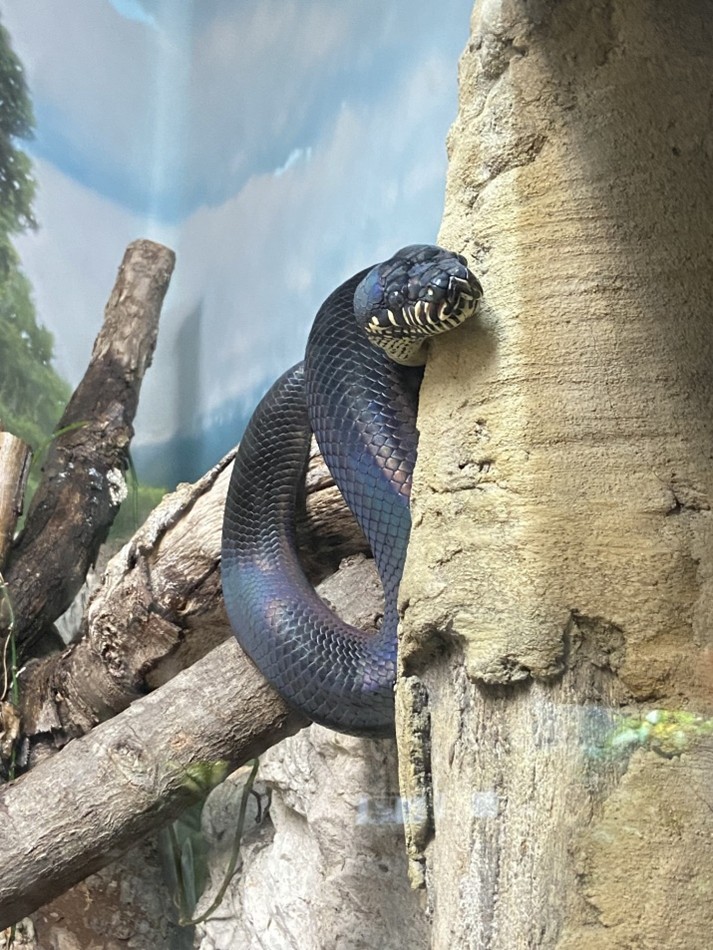Summary of The champion – Zoo Atlanta:
Sam G., a Senior Keeper in the Herpetology Department, shares insights about Boelen’s pythons (Simalia boeleni) in a post dated February 12, 2025. Discovered in 1953, these pythons inhabit the remote highland mountains of central New Guinea. Despite limited data on their population and reproduction, they are protected from poaching by local tribes due to their revered status. Boelen’s pythons are terrestrial and diurnal, feeding on cuscus, rodents, bats, lizards, and frogs. They can reach lengths of 8 to 14 feet and live up to 20 years in captivity. Females lay 4 to 15 eggs, and the hatchlings undergo a color change from reddish-orange to black as they mature. Known locally as “Blue Moran” or “Papa Graun,” these snakes are marked by a purplish-black color with iridescent scales. Zoo Atlanta houses a female Boelen’s python in the Scaly Slimy Spectacular exhibit for visitors to view, albeit she is known to be shy.
- Overview of the Boelen’s python, its habitat, and discovery
- Biology and behavior of Boelen’s python, including diet and reproduction
- Unique physical traits and color transformation of Boelen’s python
- Cultural significance and conservation challenges of Boelen’s python
- Zoo Atlanta’s role in showcasing Boelen’s python and public education
Boelen’s python, or Simalia boeleni, is a species that has captured the interest of herpetologists and animal enthusiasts alike since its discovery in 1953. Originating in the highland mountains of central New Guinea, these intriguing creatures have mastered survival in a rugged and remote landscape, far removed from most human activities. This isolation, while helping avoid numerous threats that other species face, also results in a lack of comprehensive research into their population numbers and habits in the wild.
Boelen’s pythons are primarily terrestrial and diurnal, engaging in their daily life activities from sunup to sundown. Their diet is opportunistic and varied, ranging from cuscus—a marsupial native to the region—to rodents, bats, lizards, and frogs. Despite the unpredictable availability of prey in its mountainous homeland, Boelen’s python has shown adaptability in its eating habits. Adult pythons typically reach lengths of about 8 feet, though they can grow as long as 14 feet in some cases. Under human care, they can live up to 20 years, offering zoologists ample opportunity to study them in controlled environments.
Reproduction in Boelen’s python involves a fascinating parental strategy where females lay a clutch of four to fifteen eggs and coil around them to protect and incubate them until they hatch. Hatchlings emerge at approximately 2 feet in length, marking the start of their transformation both in size and color.
One of the most captivating features of Boelen’s python is its ontogenic color shift. Hatchlings display a vibrant reddish-orange hue, which gradually turns to a distinguished black as they mature. Accompanying this color change is an iridescent sheen on their scales, often described as resembling an oil slick, adding to their visual allure. Their belly usually holds a pale color palette of white or yellow, highlighted by streaks that extend up the sides of their robust body.
The Boelen’s python holds significant cultural importance for local tribes across their natural territory. Revered as sacred, these snakes are often protected from hunting and poaching efforts in some areas, though this cultural protection can’t always safeguard them from broader environmental threats. The paucity of data regarding their numbers and behavior in natural habitats complicates efforts to establish conservation priorities or protective measures in their favor.
Zoo Atlanta plays a pivotal role in bringing this remarkable snake to the forefront of conservation and education efforts. As part of their Scaly Slimy Spectacular exhibit, a female Boelen’s python offers visitors a chance to encounter this elusive species in person. This opportunity fosters an understanding of the snake’s ecology and the challenges it faces, instilling a greater appreciation and awareness in the public. Educational programs and interactions with the zoo’s expert staff, like Sam G. from the Herpetology Department, enrich visitors’ experiences, highlighting the importance of biodiversity and conservation efforts both within the zoological setting and in wild ecosystems.
Boelen’s python serves as a symbol of our planet’s biological richness and the urgent need to protect its diverse inhabitants. By bridging the gap between remote wilderness and urban audiences, institutions like Zoo Atlanta offer a channel for engagement, learning, and action, promoting a future where such remarkable species are understood and preserved for generations to come.


